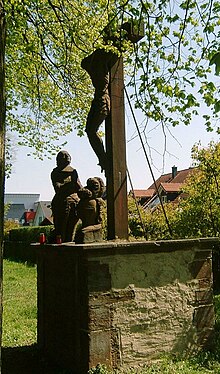Kleine Schönbuschallee
The Kleine Schönbuschallee in the Lower Franconian town of Aschaffenburg is a former promenade that, starting from Johannisburg Castle, connects the city center of Aschaffenburg with the Schönbusch Park over the Willigis Bridge . Measured from the Mainbrücke / Großostheimer Strasse to the park entrance, it has a length of 2.3 km.
history
The avenue was first laid out in 1766 under the Elector of Mainz and Archbishop Emmerich Joseph von Breidbach zu Bürresheim, presumably based on the model of the historic Heidelberg - Schwetzingen avenue between the Main Bridge and the Nilkheimer grove as a mulberry avenue . The seedlings were obtained from the Kurpfälzische Mulbeerdirektion zu Heidelberg.
In the Nilkheim forest, one of the three Kurmainzian pheasantries in the Main Valley was laid out as early as 1731 . The other two pheasantries near Froschhausen and Kleinauheim are now a wet biotope or animal park (see: Wildpark Alte Fasanerie ). Even the pheasantry in the Nilkheimer Wäldchen had the character of a zoo with a hunter's house, avenues, fountains, a fish pond and a hut in which a “Schuhu” ( eagle owl , Bubo Bubo ) was kept at the time the Kleiner Schönbuschallee was built. The Kleine Schönbuschallee served as a promenade between Johannisburg Castle and the Nilkheim forest. There are accounts showing that the avenue was lit with torches for festivities.
With the creation of the Schönbusch landscape park around 1780, the Kleine Schönbuschallee was shortened by approx. 500 m to the level of the farm building. The regular rows of trees on the mulberry avenue were loosened up with other tree species and in this way adapted to the English garden style .
The Kleine Schönbuschallee is called " Avenue d´Aschaffenbourg " in the first plans by the architect Emanuel d'Herigoyen . With the naming of the almost parallel Frankfurter Chaussee (a pure poplar avenue, today Darmstädter Strasse, Bundesstrasse 26 ), which was completed in 1780, it was named "Kleine Allee". With the creation of further avenue streets in Aschaffenburg (Ludwigsallee, Bismarckallee) the names Große Schönbuschallee and Kleine Schönbuschallee became common. The so-called Alleefeld is located between the large and small Schönbuschallee . Because of the historical line of sight between Johannisburg Castle and Schönbusch Castle, it has been kept free of taller plants and buildings. In 1843 the Kleine Schönbuschallee was planted with German poplars. After 1859 the poplars were replaced by robinia and linden.
The construction of the Main harbor in the district of Leider (1914 to 1921) and its connection to the Bachgaubahn required a level crossing of the avenue with a railroad track.
When the Willigis Bridge was built in 1969, the Kleine Schönbuschallee was connected to the new bridge and to Großostheimer and Darmstädter Strasse through two pedestrian underpasses. Around this time the Kleine Schönbuschallee was cut through by the construction of the urban ring road. Since then, a concrete arch has spanned the Ringstrasse and connects the two sections of the avenue.
List of monuments
Kleine Schönbuschallee is listed under number D-6-61-000-145 in the Bavarian list of monuments. It is owned by the city of Aschaffenburg to the east of the port railway crossing it. The paved area has been widened there and given a curved roof profile. To the west of the port railway, the avenue belongs to the Free State of Bavaria . In this part, the path area still has its original width, has a flat cross-section like the park paths of the Schönbusch and therefore has to be drained through side pockets. This part of the Kleine Schönbuschallee is maintained by the Bavarian Administration of State Palaces, Gardens and Lakes .
Johanniterkreuz
In 1780 the so-called Johanniterkreuz, a memorial cross erected on the occasion of the murder of the knight Johann Walter von Kerpen , was moved to the avenue. The knight of the Order of St. John was murdered on February 6, 1627 at the age of 25 by his companions at the Nilkheimer grove. His relatives had the memorial cross built from red Main sandstone. It stands east of the port railway crossing and is noted on the list of monuments.
Father Bernhard Monument
The memorial at the eastern end of Kleiner Schönbuschallee, which was first erected in 1931 by Otto Gentil and moved to its present location around 1969, is also entered in the list of monuments. It commemorates the surrender of the city of Aschaffenburg to the troops of King Gustav II Adolf of Sweden on November 23, 1631, around which the legend of Father Bernhard is entwined. The head of the Capuchin monastery is said to have given Gustav II Adolf the key to the city and thus saved the city of Aschaffenburg from destruction. In fact, it was not the head of the monastery but the penal attorney who presented the king with the city keys.
literature
- Kurmainzer Chausseebau in Maintal and Spessart , in Aschaffenburg yearbook for history, regional studies and art of the Untermaing area, 24th year 2005, p. 143, ISBN 978-3-87965-103-0
swell
- ^ Kurmainzer Chausseebau in Maintal and Spessar in: Jost Albert, Werner Helmberger: The landscape garden Schönbusch near Aschaffenburg , Worms 1999, ISBN 3-88462-144-0
- ↑ Moments in Aschaffenburg's history ( Memento from September 18, 2010 in the Internet Archive )
1. Hans Sommer: Kurmainzer Chausseebau in Maintal und Spessart in: Aschaffenburger Jahrbuch für Geschichte, Landeskunde und Kunst des Untermaingebietes, 24. Jahrg. 2005, ISBN 978-3-87965-103-0, S. 143 ff.
2. Jost Albert, Werner Helmberger: Der Landschaftsgarten Schönbusch bei Aschaffenburg, Worms 1999, ISBN 3-88462-144-0
Web links
Coordinates: 49 ° 57 ′ 52 ″ N , 9 ° 6 ′ 41 ″ E


